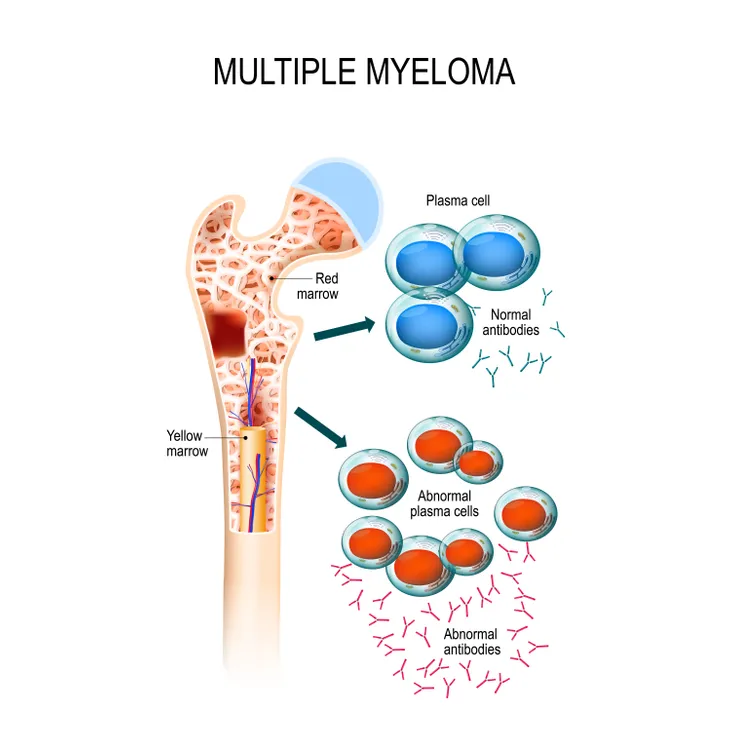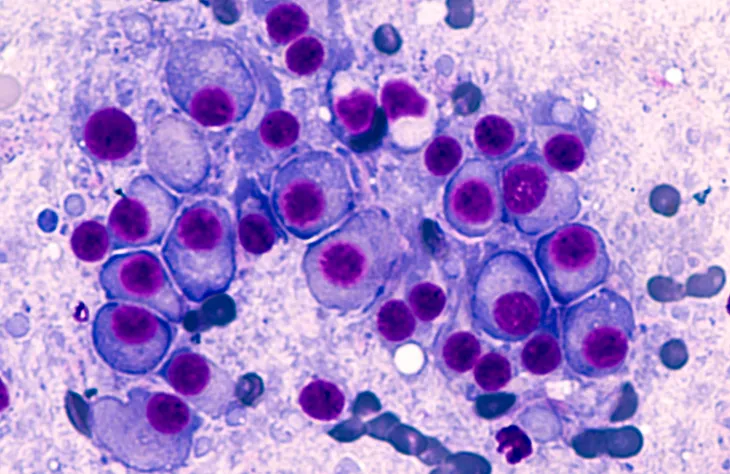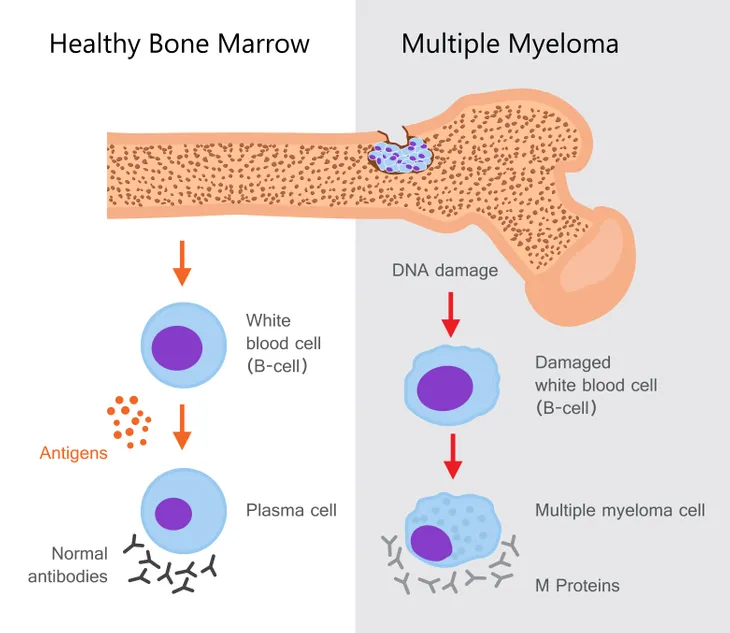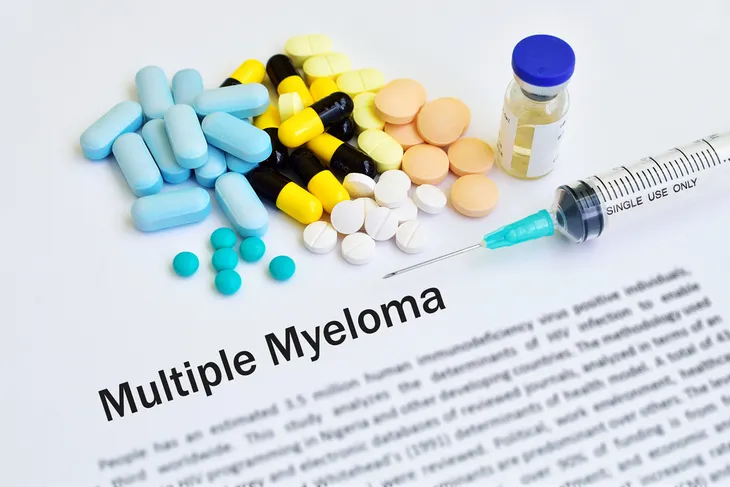Cancer can be fatal no matter which form it takes, but certain types of cancer can target even the healthiest of people. Multiple myeloma is a rare cancer that targets the senior community — and anyone over age 60 is at risk. Perform a search online today to learn more.
What Is Multiple Myeloma?
Multiple myeloma is an extremely rare type of cancer. It is a type of blood cancer that invades the bone marrow (spongy tissue in the bone) and causes abnormal behavior, as well as uncontrolled growth of a specific type of white blood cell, the plasma cells.
The plasma cells are “a type of white blood cell and are responsible for recognizing foreign infections and making antibodies to fight them,” writes Healthline. Plasma cells live in the bone marrow and are responsible for making other healthy cells. But when the body is overtaken by multiple myeloma, cancer cells overtake the healthy blood cells, stopping them from being able to produce new healthy cells and antibodies to fight off infection.
 novak.elcic / Shutterstock
novak.elcic / ShutterstockCommon Symptoms of Myeloma
Like many other health conditions, the signs and symptoms of multiple myeloma aren’t so cut and dry. Many people don’t experience any symptoms in the early stages of cancer, so it can be hard to detect. Of course, as the cancer advances and becomes more serious, it begins to show more signs. Healthline still warns that it’s hard to give an overall draft of what every person will experience, because it can be different for each person.
Many people will experience fatigue as the body tries to fight off invading germs. “As myeloma cells replace bone marrow, your body has to work much harder with fewer disease-fighting cells, and you tire more easily,” writes Healthline. You might also experience bone problems as the disease prevents the body from making new bone cells. This can lead to bone pain, weakened bones, and broken bones.
Multiple myeloma can also cause kidney problems as it produces “harmful proteins that can cause kidney damage and even failure,” writes the source. You will likely be battling a low blood count as the myeloma cells crowd out the healthy blood cells. This leads to a slew of other problems including frequent infections, and low red and white blood cell counts, which makes it hard to fight infection.
Other Signs and Symptoms
We just listed a bunch of pretty serious signs and symptoms that come along with multiple myeloma, particularly as the cancer becomes more advanced. A lot of the symptoms above are fairly general, so now we’re going to get into a list of symptoms that are a little more specific. A patient won’t experience every single symptom on this list, but may experience a handful.
Healthline lists the following as additional signs and symptoms: “nausea, weight loss, constipation, loss of appetite, weakness or loss of feeling in your legs, swelling in your legs, increased thirst, frequent urination, dizziness, confusion, and pain, especially in your back or belly.”
What it Does to the Body
Cancer cells operate in a much different manner than normal, healthy cells. Instead of maturing and then dying away, cancer cells will live on and accumulate. When it comes to multiple myeloma, these cells duplicate at a rapid pace and will eventually take over the bone marrow. “The production of cancer cells outpaces the production of healthy blood cells, and the cancer cells crowd out the healthy ones,” writes Healthline. This will cause the patient to feel fatigued, give them frequent infections, and possibly cause them to develop anemia.
Instead of helping the body by producing antibodies, which is what healthy, normal plasma cells would do, Healthline reports the myeloma cancer cells produce abnormal and harmful antibodies. “Your body can’t use these antibodies, called monoclonal proteins, or M proteins. Over time, these proteins build up in your body and can damage your kidneys,” writes the source.
Causes of Multiple Myeloma
Unfortunately, researchers are still unclear about what causes multiple myeloma. What we do know is that multiple myeloma begins with “one abnormal plasma cell in your bone marrow — the soft, blood-producing tissue that fills in the center of most of your bones,” says the Mayo Clinic. These abnormal cells will then multiple rapidly. As we mentioned above, cancer cells are different from healthy, normal cells, because they don’t mature and die off. Instead, they multiple rapidly, eventually overwhelming all the healthy cells. “In the bone marrow, myeloma cells crowd out healthy white blood cells and red blood cells, leading to fatigue and an inability to fight infections,” adds the clinic.
The myeloma cells will try and act like healthy plasma cells by producing antibodies, but these antibodies are abnormal and the body can’t use them. “Instead, the abnormal antibodies (monoclonal proteins, or M proteins) build up in the body and cause problems such as damage to the kidneys,” writes the source. Cancer cells also pose a threat to the bones, increasing the risk of broken bones.
Link to Monoclonal Gammopathy of Undetermined Significance
More often than not, multiple myeloma begins as a benign condition called monoclonal gammopathy of undetermined significance (MGUS). According to the Mayo Clinic, about 3-percent of people over the age of 50 have this condition. Every year, 1-percent of people with this condition will go on to develop multiple myeloma.
“MGUS, like multiple myeloma, is marked by the presence of M proteins — produced by abnormal plasma cells — in your blood,” writes the Mayo Clinic. “However, in MGUS, the levels of proteins are lower and no damage to the body occurs,” adds the source.
Risk Factors for Multiple Myeloma
There are several factors that can put a person at an increased risk for developing multiple myeloma. The first is age. Healthline points out that the majority of patients who are diagnosed with this cancer are in their mid-60s. The American Cancer Society notes that the percentage of cases involving patients under the age of 35 are less than 1-percent. The next risk factor listed by the source is race. According to Healthline, African-Americans are twice as likely to develop this type of cancer. This also goes for men in general. They are more likely to develop multiple myeloma than women.
Family history definitely plays a large role. “If you have a sibling or a parent with [multiple] myeloma, you’re more likely to be diagnosed than someone without a family history of the cancer, according to the American Cancer Society,” writes Healthline. But, it’s important to note that this source also points out that only a small percentage of cases can be linked back to family history. So, it’s doesn’t play a huge role in risk factors.
A study published in journal Oncologist linked obesity and being overweight to an increased risk of developing multiple myeloma. Lastly, Healthline notes that in most cases, “Multiple myeloma begins as a benign condition called [MGUS], which is marked by the presence of M proteins.” Only 3-percent of Americans over the age of 50 have MGUS, says the Mayo Clinic.
Complications of Multiple Myeloma
As if a diagnosis of multiple myeloma isn’t bad enough, it can come with some pretty serious and uncomfortable complications. Healthline lists four main complications, starting with frequent infections. “As myeloma cells crowd out healthy plasma cells, your body becomes less able to fight infections,” writes the source. It can also cause anemia, which is a result of the normal blood cells being pushed out of the bone marrow and replaced with cancer cells. This is what leads to blood problems.
Multiple myeloma can also cause bone problems, including pain and weakened or broken bones. It can also lead to reduced kidney function, which means “M proteins are harmful antibodies produced by the myeloma cancer cells,” writes Healthline. “They can damage your kidneys, cause problems with kidney function, and eventually lead to kidney failure,” adds the source. In addition to all this, bones that are damaged and eroding can cause your blood calcium levels to increase, which interferes with the kidney’s ability to filter waste.
Diagnosis
Multiple myeloma is typically diagnosed one of two ways, it’s either found accidentally when testing the blood for a completely different condition or when a doctor might suspect this condition based on the signs and symptoms of the patient. There are several different tests or procedures that are available to help determine whether or not a patient has this disease.
The first and easiest is a blood test, says the Mayo Clinic. “Laboratory analysis of your blood may reveal the M proteins produced by the myeloma cells,” writes the source. “Another abnormal protein produced by the myeloma cells — called beta-2-microglobulin — may be detected in your blood and give your doctor clues about the aggressiveness of your myeloma.” Blood tests can also determine how the kidneys are functioning, blood cell counts, calcium levels, and uric acid levels.
The patient can also have a urine test which could also show M proteins (also known as Bence Jones proteins). The doctor could examine the patient’s bone marrow by taking a sample for testing. This sample is extracted using a long needle that is inserted into a bone. The bone is then tested for myeloma cells. Lastly, this condition can be diagnosed with imaging tests, such as an X-ray, MRI, CT scan, or positron emission tomography (PET) scan, says the Mayo Clinic.
Stages of Multiple Myeloma
As with many other cancers, there are different stages for multiple myeloma. When a doctor discovers myeloma, they will do their best to assign a stage to the cancer, which is based on how much the cancer has grown or spread. They are able to tell what stage a patient is at based on an X-ray of the bones and by testing the blood, urine, and bone marrow.
The first stage is called smoldering myeloma. This is extremely early in the disease when there are no symptoms or problems, says WebMD. During this stage, the kidneys and blood are still normal and there is no bone damage. Anyone who is diagnosed with myeloma during this stage will not require treatment.
Stage 1 means there aren’t many multiple myeloma cells in the body, and there is no visible damage on X-rays, but the cancer may have damaged one area of the bone. When testing the blood, calcium levels are normal, but other blood tests might be abnormal.
According to WebMD, stage 2 is really just a middle ground between stages 1 and 3. During this stage, there are simply more myeloma cells in the body than there would be in stage 1. Lastly, during stage 3 the doctor will find “many myeloma cells, and the cancer has destroyed three or more areas of bone. Blood calcium is high, and other blood tests are abnormal,” writes the source.
Treatment Might Not Be Needed
According to the Mayo Clinic, there are some people who have multiple myeloma who cannot receive treatment or do not need it yet at their particular stage of disease (for example, those who have been diagnosed with smoldering myeloma). These are most likely the patients who aren’t experiencing any symptoms. Patients who do not receive treatment will be monitored closely by their doctor, looking for any signs of progression. The source explains that this will likely require regular blood and urine tests.
“If you develop signs and symptoms or your multiple myeloma shows signs of progression, and your doctor may decide to begin treatment,” says the Mayo Clinic.
Treatment
As we previously mentioned, some people do not require treatment, but most patients do. There are several different standard treatments available, including different types of therapy, transplant, and medication. The first form of treatment listed by WebMD is immunomodulatory drugs, which work to boost the immune system so that it can turn on immune cells and “stop signals that tell cancer cells to grow so they kill myeloma cells.” There are also proteasome inhibitors, which work to stop cancer cells from getting rid of old proteins so that their old proteins build up, causing the cancer cells to die, says WebMD.
Steroids can be used throughout all stages of the disease to ease symptoms and kill multiple myeloma cells. Histone deacetylase (HDAC) inhibitors will help “stop multiple myeloma cells from making too much of the [HDAC] protein, which helps malignant cells quickly grow and divide,” explains the source. There are also monoclonal antibodies, which are immunotherapy drugs that help boost the immune system and bring in antibodies to target the specific proteins and fight cancer. Patients can also try chemotherapy or radiation therapy.
As the cancer develops and if there are issues with the treatment, other options might be adjunctive care, which helps manage the side effects of any medications and complications of the disease. Supportive care can help patients who are living with multiple myeloma and need assistance in getting through day to day life, including physical therapy, nutritional counseling, massage, exercise, etc. Lastly, WebMd lists hospice care as an option for patients who are no longer responding to treatment, but need to receive treatment to make them more comfortable as they life out the rest of their life.
Coping and Support
Any cancer diagnosis no matter what type or stage is upsetting, shocking, and devastating. The amount of stress and trauma associated with it can differ for each person depending on their unique experience. But in every case, there is some level of coping that needs to happen, and more often than not, it requires asking for help from family, friends, and professionals. Patients who have been diagnosed with multiple myeloma need to get educated about their disease and the treatments available. They need to have a strong support system. As we just mentioned, this support system can come in many different forms, either friends, family, or even from a formal support group with other people who are going through the same thing.
The Mayo Clinic encourages patients to set goals for themselves, so they can feel like they have some control over their life. Of course, these goals should be made and kept within reason, so the patient isn’t setting themselves up for failure. Lastly, they need to set aside time for themselves. We all lead very busy lives and often forget to take time to eat well, exercise regularly, get enough sleep, and just relax! Be proactive in planning some much needed time for rest and relaxation.















